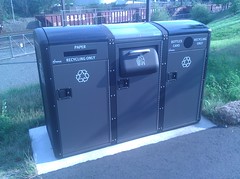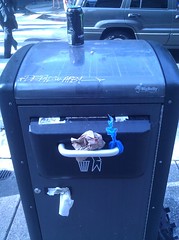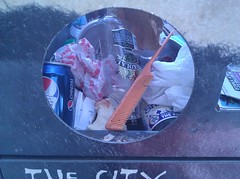This is my third logbook entry for my Human-Computer Interaction (HCI) course.
A few years ago, Philadelphia replaced many of the garbage cans with BigBelly Solar trash compactors.

2 recycling bins and a solar compactor in Penn Park
I’d first seen Big Belly at a park in Chicago. It seemed like a great idea: the smart trash can compacts refuse so that it needs to be collected less frequently, and even sends out a signal to the grounds crew when it is full, so that there’s never an overflowing trash receptacle (the latter was a big problem in Philly, especially on weekends).
Time Magazine recently ran an article on BigBelly (“Trash Talk“), particularly citing their success in Philadelphia. I still think the solar compactors are a great improvement over the overflowing trash cans of years past. The streets are cleaner, and they save money. But from a resident’s perspective, I think they have room for improvement.
The Handle
My primary issue is with the handle: the user’s main interface with the device. Honestly, I don’t think I would have realized that the handle is a problem if it hadn’t been for my wife. She’s a bit of a germaphobe, or slightly OCD if you will. She will only open the trash can if she has a napkin or a paper sack handy so that she never actually touches the handle with her skin. After coming to terms with her foible, though, I noticed that a lot of other people do the same. Sometimes people put trash on top of the container, presumably because they don’t want to touch it. I don’t really blame them, either: some of the trash cans look pretty grimy these days.

(Do you want to touch this? Many people would refuse.)
The compactor unit undoubtedly needs to confirm that it is fully closed before compacting the trash within, otherwise there is a risk someone could get a limb caught inside. But I wonder: how difficult would it be to add a foot pedal that would open the bin?
The Recycling Bin
About half of the Big Belly units stationed around the city have an adjacent recycling receptacle. Philadelphia uses single-stream recycling, so all the recyclable materials are co-mingled. The bins do give you some good hints (affordances) as to what should be added, though: a round hole large enough to accommodate drink bottles and cans, and a thin slot that suggests newspapers. These bins typically are labeled “Recycling Only” and “Bottles and Cans” under the round hole, and “Paper” under the thin slot.
Since the recycling has to get separated and sorted after it is collected, it cannot be compacted. That means that the recycling is frequently full (or overflowing). It does not, that I know of, have a mechanism to contact anyone when it is full the way the trash cans do. (I’d guess that a lot of the waste comes from food and drink containers, so bottles and cans probably make up a sizable percentage of waste by volume).
Also, people end up putting trash in the recycling bins.

(Last time I checked, apple cores were not recyclable.)
Here are some plausible reasons why this might happen:
- The handle to open the trash compactor is unappealing/repulsive
- The recycling containers look nearly identical to the trash cans
- The hole for bottles and cans is just the right size for your hand (the affordance is not specific enough: it signifies that you should put something through the hole, but not what)
- Philadelphia has covered up the recycling labels with anti-littering messages.
Although some people abuse the containers in malicious ways (e.g. graffiti, chewing gum), I’d guess that most people who make the effort to place refuse in one of these bins assumes that he or she is doing the right thing.
My Suggestions
- Add a foot pedal to open the bin (in addition to the handle). This would allow germaphobes to deposit trash.
- Don’t cover the recycling labels! I can’t believe Philadelphia did this. The anti-littering message (rather than a pro-recycling message) practically implies that the receptacle is for litter.
- Change the opening for bottles and cans. The round opening is suggestive, but not necessarily suggestive of recycling. One idea is to make the opening smaller, although an opening just large enough for 12 oz. soda cans and 20 oz. bottles might exclude certain oversize items (sports drink bottles like Gatorade). The consequences of separating trash from the recyclables at the processing center may be less costly than diverting larger plastic containers to the trash.
- Make the recycling bins recognizably different from the trash compactors. Currently they are the same color, same shape, and side-by-side. They need to be easily differentiated from one another.
- Make the recycling bins larger where necessary. Recycling items such as cans and bottles take up a lot of volume and are items commonly discarded on the street. These bins are regularly full and overflowing in well-trafficked areas of the city. Alternatively, they could provide a “full” signal so that the sanitation department can empty them when necessary.
- Build the trash compactors to withstand abuse. Broken handles and broken hinges indicate that Philadelphians are pretty rough on their trash bins. Those nice Bostonians (BigBelly is based in suburban Boston) may treat their trash cans with respect, but Philly likes to knock ’em around.
Have you seen or used a BigBelly solar compactor? I’d love to know your thoughts and suggestions!